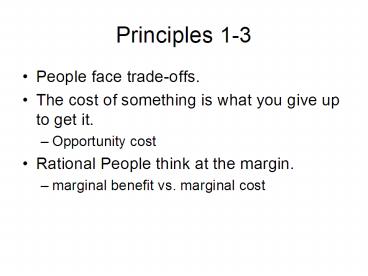Principles 13 PowerPoint PPT Presentation
1 / 20
Title: Principles 13
1
Principles 1-3
- People face trade-offs.
- The cost of something is what you give up to get
it. - Opportunity cost
- Rational People think at the margin.
- marginal benefit vs. marginal cost
2
Principles 4-6
- People respond to incentives.
- Mechanism design
- Trade can make everyone better off.
- Specialization
- Markets are usually a good way to organize
economic activity. - Decentralization
3
Principles 7-10
- Governments can sometimes improve market
outcomes. - Externality, coordination, etc.
- A countrys standard of living depends on its
ability to produce goods and services. - Prices rise when the government prints too much
money. - Society faces a short-run trade-off between
inflation and unemployment.
4
Theory vs. Empirics
- One improves on the other.
- A good theory needs to be parsimonious and
testable rather than complex and assertive. - Empirics need to be constructed rather than
accumulated. - Theory guides where and how to look at.
- Empiric guides what to correct and find.
5
Example
- Accumulation of facts
- A king and a queen lived in a country.
- The queen died.
- The king died later.
- Hypotheses
- The king died, because he was so sad.
- The king died, because he was so excited.
- Empirics
- Check if the king was sad or happy.
6
Example (cond)
- If the king was sad (excited), the first (second)
hypothesis is supported by the empirics. - If the king was neither sad nor excited, a new
hypothesis theory is needed. - If supported, empiricists check if the hypothesis
is generalizable. - If so, the hypothesis becomes a theory.
- If not, the hypothesis needs to be modified or
discarded.
7
Positive vs. Normative
- Positive economics answers what it is.
- Normative economics answers what it ought to
be.
8
Pareto Optimality
- Pareto optimality An economic outcome is said to
be Pareto optimal if it is impossible to make
some individuals better off without making some
others worse off. - A minimal and uncontroversial test that any
social optimal economic outcome should pass
9
When Normative Comes In?
- An economic outcome is not Pareto optimal.
- Value judgments are needed.
- Political problems, yet positive economics helps
to resolve the problems.
10
Caveats
- The boundary is not clear-cut.
- A value judgment is already contained in the
choice of questions, methodologies, and
communication tools.
11
Production Possibilities Frontier
- What combination of goods can you produce per
unit time? - 24 hours are given to Adam and Eve.
- Adam can produce 10 apples or 20 bananas in 24
hours. - Eve can produce 6 apples or 18 bananas in 24
hours. - Some other combinations are possible.
12
Absolute Advantage
- The ability to produce a good using fewer inputs
than another producer. - Adam uses 2.4 hours to produce one apple.
- Eve uses 4 hours to produce one apple.
- Adam uses 1.2 hours to produce one banana.
- Eve uses 4/3 hours to produce one banana.
- Adam has an absolute advantage in producing both
apples and bananas over Eve.
13
Comparative Advantage
- The ability to produce a good at a lower
opportunity cost than another producer. - Adams opportunity cost of an apple is 2
bananas. - Adams opportunity cost of a banana is 1/2
apple. - Eves opportunity cost of an apple is 3 bananas.
- Eves opportunity cost of a banana is 1/3 apple.
14
Comparative Advantage (cond)
- Adams opportunity cost of an apple is lower than
Eves. - Adam has a comparative advantage in producing
apples. - Eves opportunity cost of a banana is lower than
Adams. - Eve has a comparative advantage in producing
bananas.
15
When to Trade?
- The price of one good should be between the
opportunity costs of the traders of the good. - Suppose the price of an apple is 2.5 banana.
- One trader has an incentive to buy.
- Even pays 0.5 fewer banana by buying.
- The other trader has an incentive to sell.
- Adam gets 0.5 more banana by selling.
16
When not to Trade
- The price of one good is beyond the opportunity
cost of one of the traders of the good. - Suppose the price of an apple is 1 banana.
- One trader has an incentive to buy.
- Eve pays 2 fewer bananas by buying.
- But the other trader does not have an incentive
to sell. - Adam loses 1 banana by selling.
17
Another Example
- 24 hours are given to Adam and Eve.
- Adam produces 12 desktops and 24 notebooks in 24
hours. - Eve produces 24 desktops and 6 notebooks in 24
hours. - Some other combinations are possible.
18
Absolute Advantage
- Adam produces 0.5 desktop and 1 notebook per
hour. - Adam has an absolute advantage in producing
notebooks over Eve. - Eve produces 1 desktop and 1/4 notebook per
hour. - Eve has an absolute advantage in producing
desktops over Adam.
19
Comparative Advantage
- Adams opportunity cost of 1 desktop is 2
notebooks. - Adams opportunity cost of 1 notebook is 1/2
desktop. - Eves opportunity cost of 1 desktop is 1/4
notebook. - Eves opportunity cost of 1 notebook is 4
desktops.
20
Comparative Advantage (cond)
- Adam has a comparative advantage in producing
notebooks. - Eve has a comparative advantage in producing
desktops. - In this case, the owner of the comparative
advantage in producing one good is the same as
the owner of the absolute advantage in producing
the good. - This happens when no one dominates the other in
producing both goods.

